Some birds have distinctive plumage, some have curious behaviors, while others have huge beaks! Moreover, some have all three characteristics – which is why they’re some of the world’s most notable birds.
That’s the reason we’ve decided to share 16 birds with big beaks that also feature other remarkable characteristics. Furthermore, we’ve selected some fun facts about each. Keep reading to learn more!
16 Birds with Big Beaks
Some birds have long, thin beaks, and most use them to catch food in the water or mud (among other purposes, of course). But what about the birds with long (or even short) but wide beaks? Do they use their bills in the same way? Not exactly!
While every bird’s beak serves as means of building nests, cleaning their feathers, looking for food, and feeding the young, some birds have remarkably big beaks with additional roles.
For example, the bills of some toucan species are believed to serve as sexual ornaments, thus playing an essential role in sexual selection. Moreover, these toucans use their beaks to intimidate other birds while robbing their nests and defending their territory.
Besides this, the bill of a toco toucan is known to regulate heat distribution by modifying blood flow. In short, the bill serves as a thermal radiator. Other birds’ big beaks, like those of a flamingo, are adapted to bottom scooping.
As you can see, there’s much more to a bird’s bill than its appearance! Read on to discover more about 16 species with huge beaks!
1. Shoebill
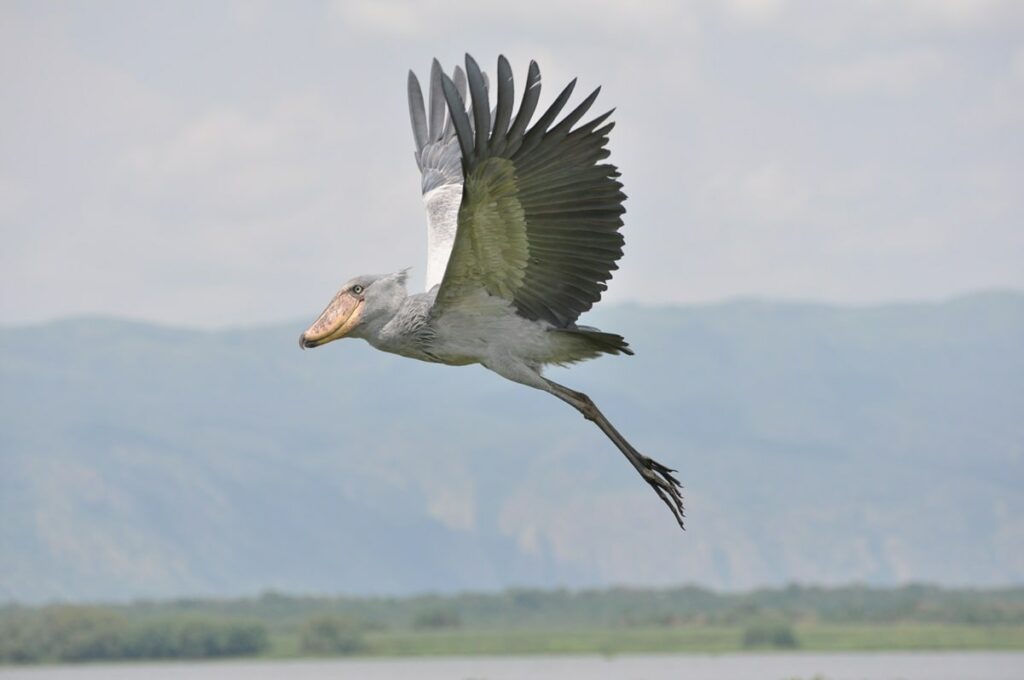
- Scientific name: Balaeniceps rex
- Size: 39 – 55 inches
- Weight: 8.8 – 15.4 pounds
- Beak length: 7.4 – 9.4 inches
The shoebill is a wading bird with a big, long beak and slender, long legs. It has overall blue-gray plumage, while the flight feathers are slate gray. Its beak is large, bulbous, and covered with grayish markings.
These birds are endemic to central tropical Africa, where they inhabit freshwater habitats. The largest population is found in South Sudan and the West-Nile subregion. Other large populations live in Tanzania and Uganda.
Although not considered migratory, shoebills sometimes move to different regions. This migratory behavior is linked to fluctuations in the surface water level.
Shoebills are solitary birds and build their nests away from other birds’ nests. Moreover, they’re extremely territorial towards their breeding grounds.
2. Toco Toucan
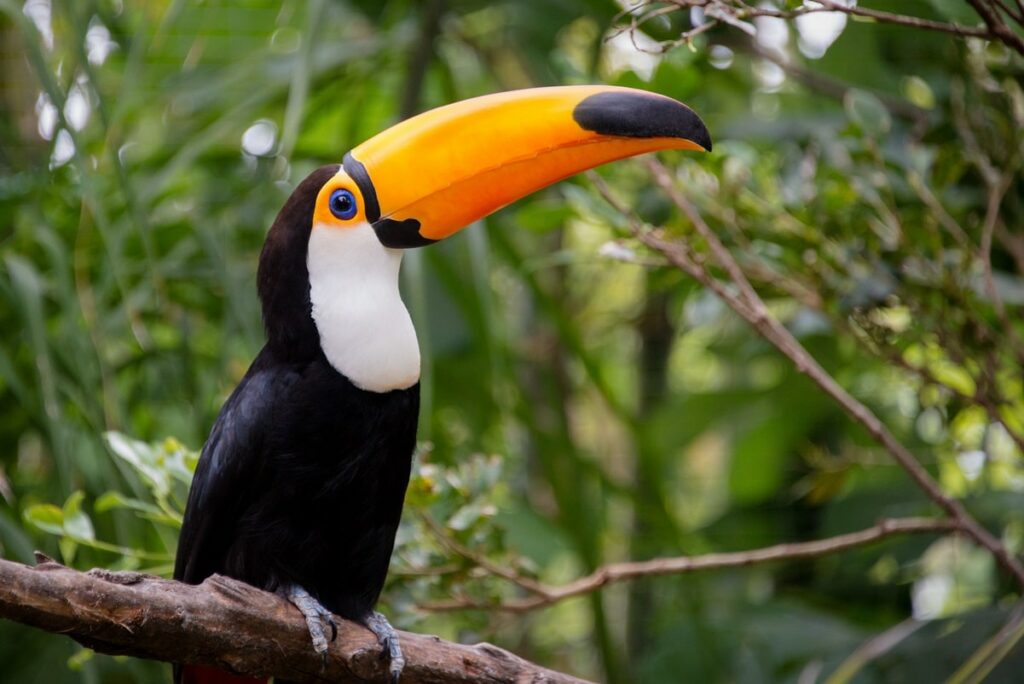
- Scientific name: Ramphastos toco
- Size: 21.5 – 25.5 inches
- Weight: 1.1 – 1.9 pounds
- Beak length: 6.2 – 9 inches
The toco toucan is considered the largest toucan in the Ramphastidae family. And more importantly, it’s well-known for its large, distinctive beak, which exhibits a bright yellow-orange color. Did you know that its tongue is almost as long as its bill?
As for the plumage – the toco toucan is almost entirely black but has a white chest, throat, and upper part of the tail, while the undertail is red.
If you want to spot a toco toucan, you can do so in South America – more precisely, in central and eastern South America. It lives in savannahs, woodlands, and open habitats and may even be seen in wooden gardens.
Toco toucans are considered residents in their natural habitats but sometimes move locally if food sources are scarce.
Their breeding season depends on where the birds live. They build their nests high in trees, although some were observed building nests in terrestrial termite nests.
Here’s something you probably didn’t know about this species – Charles Darwin thought that a toco toucan’s beak serves as a sexual ornament, as well as means of intimidation and social selection.
3. Roseate Spoonbill
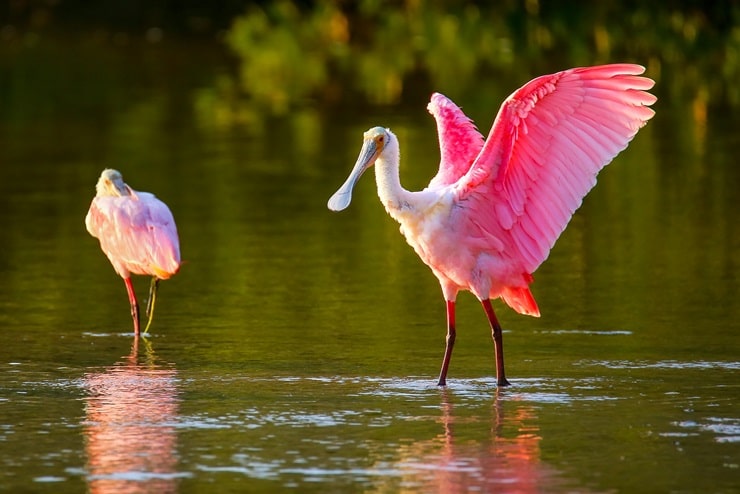
- Scientific name: Platalea ajaja
- Size: 28 – 34 inches
- Weight: 2.6 – 4 pounds
- Beak length: 4 – 6 inches
At first, roseate spoonbills may look like flamingoes, thanks to their beautiful, bright pink color. However, you can distinguish the two by the former’s greenish heads and white necks, breasts, and backs.
Spotting them shouldn’t be an issue as long as you visit their natural range – in the United States, they are common in Florida, Texas, and southwestern Louisiana; it is a common species in the Caribbean Islands, Central and South America, Mexico, and the U.S. Gulf Coast. Although their population almost went extinct in the past, they’re now listed as Least Concern, and their numbers are constantly increasing.
Look for these pink, long-legged birds near shallow fresh, or coastal waters, as these are their preferred feeding grounds. During the breeding season, you might spot roseate spoonbill nests in trees, shrubs, or mangroves.
4. Keel-Billed Toucan
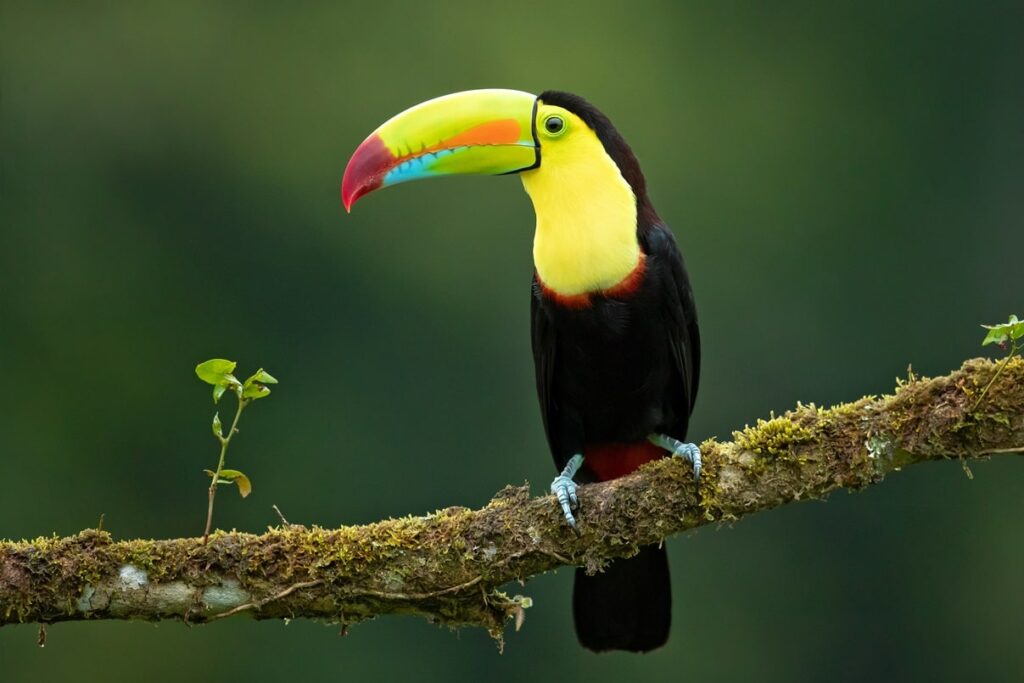
- Scientific name: Ramphastos sulfuratus
- Size: 17 – 22 inches
- Weight: 13 – 18 ounces
- Beak length: 4.7 – 5.9 inches
Yet another toucan with a big beak, the keel-billed toucan. Although keel-billed toucans have shorter beaks than those of the other species we’ve discussed, it’s certainly worth discussing. These birds’ beaks have a unique combination of green, red, blue, and orange, while the plumage is mostly black, except for the neck and chest, which are yellow.
This species lives primarily in Central America – from Southern Mexico south to Venezuela and Colombia. It prefers inhabiting canopies found in tropical and subtropical forests. If you spot a keel-billed toucan, you should check for others, as a single tree usually hosts several toucans. They are residents in their natural habitats.
This species’ breeding season usually starts during the spring. The nests are typically built in tree cavities, where females lay up to four white eggs. The diet is extremely important during the breeding season, which is when the keel-billed toucan takes advantage of its large beak – it helps the bird dissect fruits.
5. Collared Aracari

- Scientific name: Pteroglossus torquatus
- Size: 15 – 16 inches
- Weight: 6.2 – 8.8 ounces
- Beak length: 4 inches
The collared aracari is a beautiful bird that resembles the toucan in some ways. However, it has a more distinctive plumage coloration – a combination between black, cinnamon, bright red, and yellow. The large beak also has a remarkable coloration.
There are three collared aracari subspecies, distributed in different parts of the North and South American continents, being common in Mexico, Colombia, Venezuela, and Belize. Within their range, collared aracaris are found around evergreen primary forests and on cacao, coffee, or fruit plantations.
Although scientists have outlined an approximate range, their population size and exact locations aren’t fully known. Moreover, collared aracari numbers are believed to decrease, probably due to hunting and deforestation.
They are social creatures often found in groups of 6 – 15 individuals, often mixed with toucans. Their breeding season starts in January and lasts until May. Like some toucans, collared aracaris built nests in tree cavities and lay up to five eggs.
6. Rhinoceros Hornbill
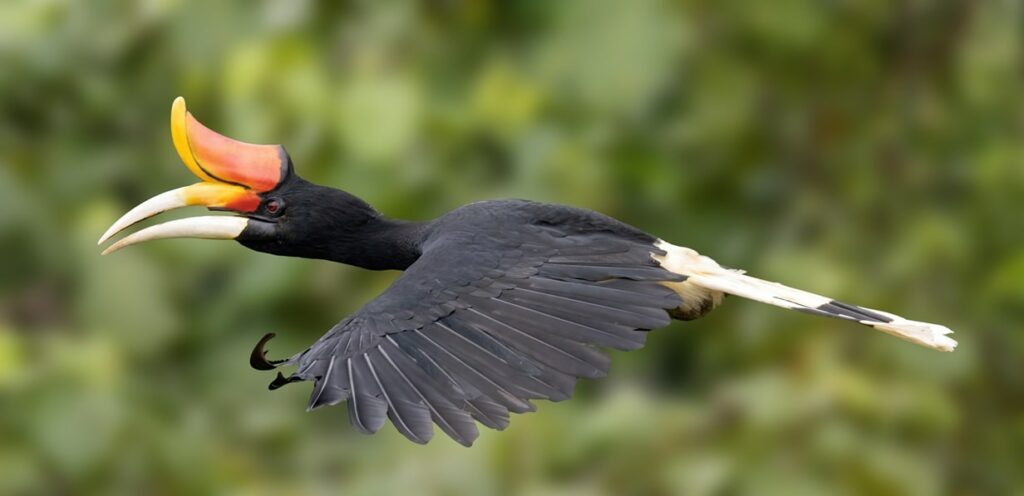
- Scientific name: Buceros rhinoceros
- Size: 31 – 35 inches
- Weight: 72 – 104.4 ounces
- Beak length: 9.2 – 12 inches
The rhinoceros hornbill is the largest among the birds we’ve listed so far. Just as its name suggests, the bird has a large bill and a distinctive casque of a reddish-orange color whose form resembles that of a rhino horn. The bird has white legs, black plumage, and a white tail featuring a black horizontal band.
These birds are primarily found in mountain rainforests. They inhabit Sumatra, Borneo, Java, Singapore, Thailand, and the Malay Peninsula. In fact, it is the state bird of Sarawak, the largest among the 13 Malaysian states. It is also Malaysia’s national bird and appears on the 5 Malaysian ringgit bill.
Rhinoceros hornbills have an interesting mating behavior that highly depends on trust. Males must earn the females’ trust – they have to prove they can provide females with the food and anything else needed while they’re staying in the nest, incubating or raising their young.
7. American White Pelican

- Scientific name: Pelecanus erythrohynchos
- Size: 50 – 70 inches
- Weight: 7.7 – 30 pounds
- Beak length: 10.3 – 15.2 inches
You’re probably already familiar with the famous pelicans. However, we’re here with some curious facts about the American white pelican specifically. First and foremost, it’s North America’s longest bird species. Secondly, the American white pelican goes second on the continent (after the California condor) in terms of wingspan length.
It features a large beak that’s flat on top and a throat sac below the bill that turns bright orange during the breeding season.
These birds are found in colonies in North American freshwater and brackish lakes. They’re also common in bays and estuaries. They are migratory birds and usually reach their wintering grounds by September or October. Most birds avoid flying over the open ocean during migration and usually overwinter on the Pacific coasts from California and Florida to Costa Rica.
American white pelicans may be spotted in colonies as large as 5,000 pairs during the breeding season! Once the winter is over, the birds prepare to leave for their breeding grounds, reaching them in March or April. Here’s another thing you probably didn’t know about American white pelicans – during the breeding season, you can notice a bump on their long beaks, which is shed once the season ends.
8. Marabou Stork
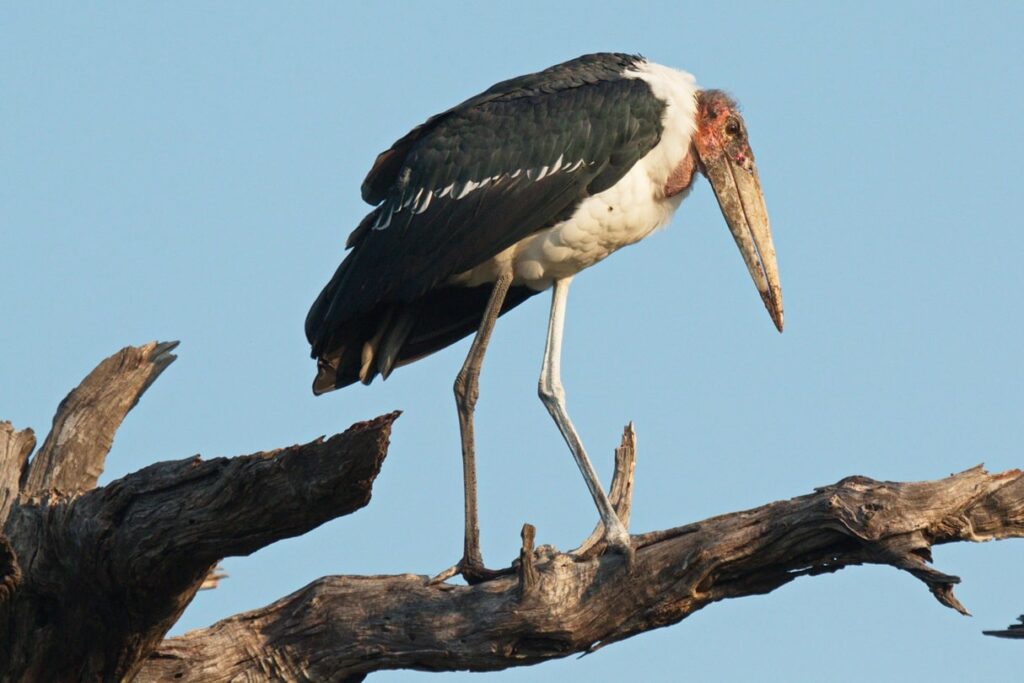
- Scientific name: Leptoptilos crumenifer
- Size: 5 – 10 feet tall; 47 – 51 inches long
- Weight: 9.9 – 17.6 pounds
- Beak length: 10.4 – 13.8 inches
The marabou stork is undoubtedly a fascinating bird! It has a black back and white underparts, and its head and neck are unfeathered. Besides having a large beak, the marabou stork is considered by some scientists the bird with the largest wingspread in the world.
These wading birds are native to sub-Saharan Africa, where they inhabit wet and arid environments.
As the previous bird on our list, the marabou stork is a colonial breeder. The individuals living in East Africa have been observed breeding in urban areas. The beginning of the breeding season is linked to the beginning of the dry season when food is more abundant.
Marabou stork nests are built in trees, where females lay 2 – 3 eggs. To “conquer” the females, male marabou storks engage in bill-rattling courtship displays and emit sounds by using their throat sacs.
9. White-Necked Raven

- Scientific name: Corvus albicollis
- Size: 19.6 – 21.2 inches
- Weight: 26.8 – 30.5 ounces
Although a white-necked raven’s beak isn’t as long as that of other birds on our list, it’s very thick, wide, and visibly arched! The bird is mostly black but features a white spot on the nape of the neck, and the plumage sometimes gets a purple gloss.
These ravens are endemic to South Africa, where they’re usually spotted in open, mountainous regions. They’re pretty common in urban areas, as well. White-necked ravens are considered local migrants traveling distances of up to around 125 miles.
Their nests are built on cliff edges and have a bowl-like shape. The ravens use sticks and twigs to build nests lined with hair, wool, or grass.
Although many people do not consider white-necked ravens distinctively beautiful, they have, instead, an interesting call – it’s similar to that of other ravens but has a noticeable whispering note. Moreover, they can mimic other birds’ calls.
10. Steller’s Sea Eagle
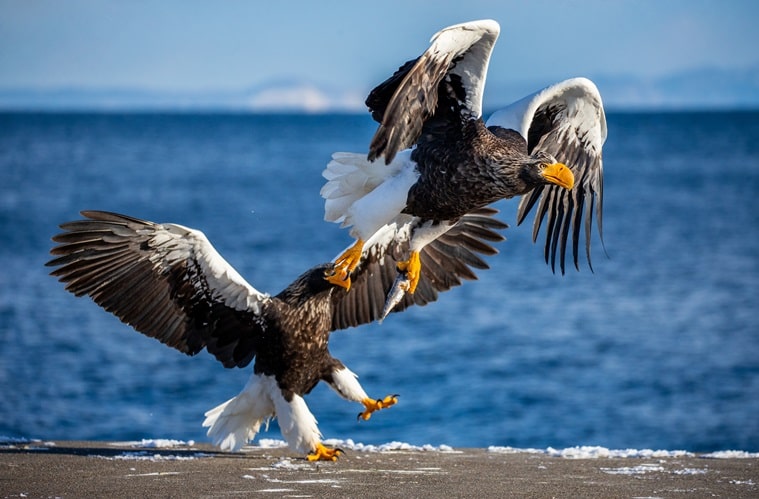
- Scientific name: Haliaeetus pelagicus
- Size: 33.4 – 41.3 inches
- Weight: 10.8 – 20.9 pounds
- Beak length: 4.6 inches
The Steller’s sea eagle is mostly black or dark brown but has contrasting white feathers on certain body parts, including the thighs and tail. Its large beak has a distinctive yellow color – just like its eyes and feet.
These large birds of prey are found only in Northeast Asia, usually close to water sources, as they feed on fish and water birds. One of the largest known populations of 4,000 individuals inhabits the Kamchatka Peninsula. Some birds are migratory; others prefer remaining year-round on their breeding grounds.
During the breeding season, these birds are found on the Kamchatka Peninsula, the Amur River, the coasts of the Sea of Okhotsk, as well as on the Sakhalin and Shantar Islands. Migratory Steller’s sea eagles fly south to Japan, Korea, or China when temperatures drop.
Steller’s sea eagles engage in courtship displays between February and March, and the greenish-white eggs are laid between April and May.
11. Flamingo
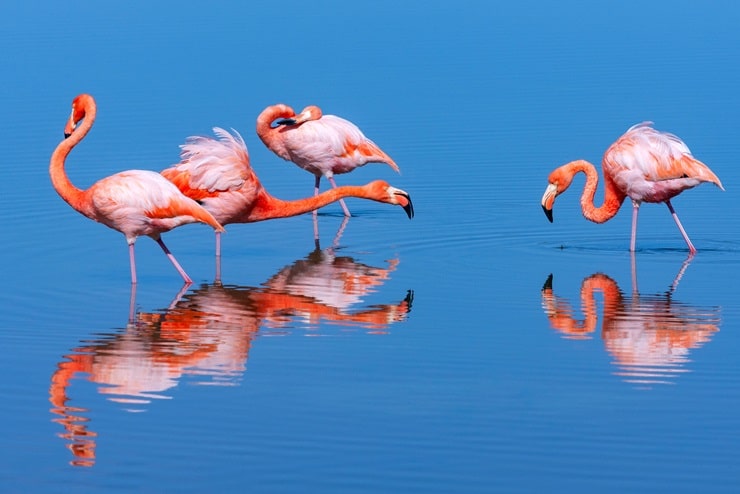
- Scientific name: Phoenicopteridae (family)
- Height: 2.6 – 4.7 feet tall
- Weight: 5.5 – 7.7 pounds
You’re probably already familiar with the famous long-legged, pink flamingoes often spotted standing on one leg! However, despite popular belief, not all flamingoes are pink – some can be bright red or have paler shades. The plumage color highly depends on how nutritious the bird’s diet is – the more nutritious, the brighter the plumage.
The distribution of these birds varies depending on the six species. Generally speaking, they’re found in Africa, Eurasia, South America, and North America.
In their natural range, flamingoes are common in wetlands like lagoons and shallow, brackish inland or coastal lakes.
They’re typically considered short-distance migratory birds that often change their homes if food sources are scarce or the habitat is disturbed.
During the breeding season, these unique pinkish birds live in colonies split into breeding groups. These groups usually consist of 15 – 50 male and female birds that exhibit a distinguishable ritual display by stretching their necks, flapping their wings, and performing specific calls.
12. Knobbed Hornbill
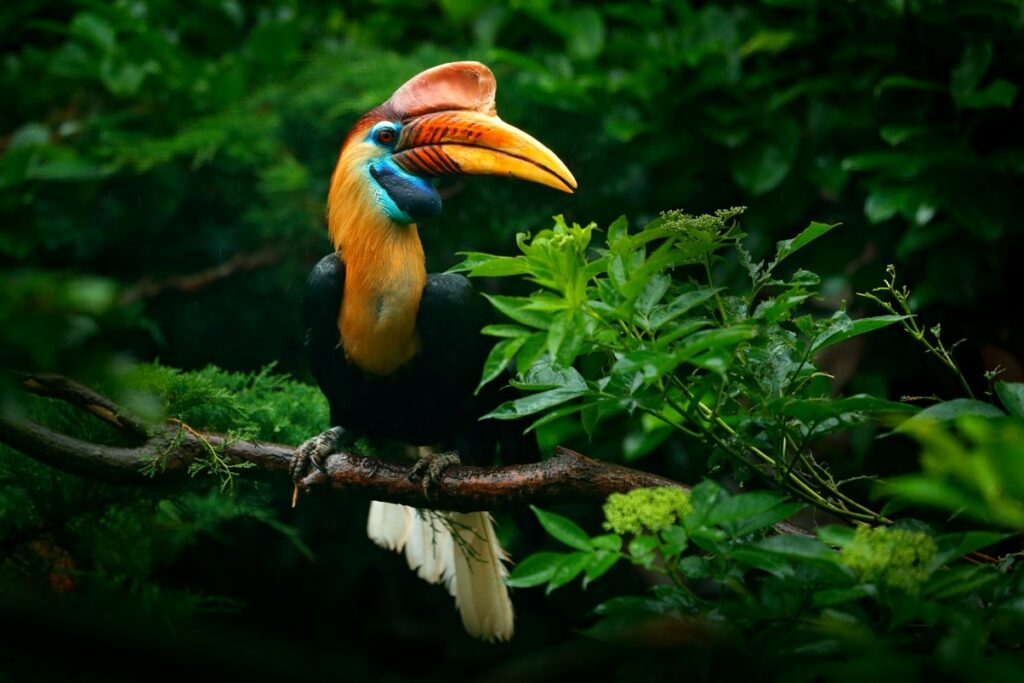
- Scientific name: Rhyticeros cassidix
- Size: 27.5 – 31.4 inches
- Weight: 5 – 5.5 pounds
As you’ve probably noticed, this is yet another hornbill species with a big beak – the knobbed hornbill also called the Sulawesi wrinkled hornbill. This bird has a distinctive coloration – a yellow bill, pale blue skin surrounding the eyes, dark blue unfeathered throats, dark feet, and white tail feathers.
This bird is native to Indonesia and lives in Buton, Lembeh, Sulawesi, Togian, and Muna Islands. It is primarily found in evergreen forests, where it has an important ecological role in seed dispersal.
Their breeding season lasts around 27 – 30 weeks and is linked to reduced rainfall. But we haven’t reached the most interesting part yet! Did you know that knobbed hornbill females use their feces to seal themselves inside tree holes to lay eggs? They leave a narrow opening for the males to bring food regularly.
13. Hyacinth Macaw
- Scientific name: Anodorhynchus hyacinthinus
- Size: 39 inches
- Weight: 2 lb 10 oz – 3 lb 12 oz
The hyacinth macaw is a parrot! It is, in fact, the world’s largest flying parrot! The hyacinth macaw is almost completely blue, except for the ring around the eyes and the area underneath the beak, which are bright yellow. While the beak isn’t too long, it’s undoubtedly very wide!
This blue parrot is found only in central and eastern South America. However, some individuals have either escaped or been released in the United States – Florida, to be precise.
They prefer inhabiting semi-open habitats and savannah grasslands. Unfortunately, their population is declining, and the species is listed as Vulnerable on the IUCN Red List.
Hyacinth macaws build their nests in tree cavities. Sometimes they may resort to cliff faces as nesting sites, although 90% of the documented nests were located in manduvi trees. This is why their population highly depends on the toucan population because the latter has an ecological role in manduvi tree seed dispersal.
14. Silvery-Cheeked Hornbill
- Scientific name: Bycanistes brevis
- Size: 30 – 31 inches
- Weight: 2.2 – 3 pounds
This hornbill has a much different beak than that of other hornbill species! It’s gray and features a creamy casque on it. The plumage is black except for some white parts, and the head is silver-gray. Moreover, studies show that silvery-cheeked hornbills have eyelashes! They protect the birds from sun and dust.
These birds are endemic to Africa and are primarily found in tall evergreen forests. They’re social creatures that live in pairs and fly in flocks of hundreds of birds.
The breeding season occurs between September and October, and the nests are built in cavities. The male helps the female seal itself in the cavity, where it lays 1 – 3 eggs.
15. Cinereous Vulture
- Scientific name: Aegypius monachus
- Size: 39 – 47 inches
- Weight: 14 – 25 pounds
A cinereous vulture’s beak is one of the features that make this large raptor look ferocious! The large beak is shiny and dark. The bird has dark plumage, while the skin on the head and neck is bluish-gray.
These birds are endemic to Eurasia. They’re found in Spain, Portugal, France, Greece, Turkey, the Middle East, Afghanistan, India, Mongolia, and Korea.
It isn’t considered a migratory bird, as it’s a year-round resident throughout most of its range. However, where the winters are harsh, some birds exhibit altitudinal movements. Moreover, some populations living in the northern limits fly to South Korea or China for the winter. Few individuals were spotted migrating to the Middle East.
Natural habitats of cinereous vultures include hilly and mountainous areas. They prefer dry semi-open environments and often build their nests near the tree line.
The beginning of the breeding season highly depends on their geographical location. For example, the birds living in Spain and Algeria start nesting in February or March, while those in Turkestan start in January.
16. Southern Giant Petrel
Scientific name: Macronectes giganteus
Size: 34 – 39 inches
Weight: 5.1 – 12.3 pounds
Beak length: 5 – 6 inches
The southern giant petrel is often called the Antarctic giant petrel or the stinker. This seabird’s large beak is yellow and features a green tip. The legs are grayish brown, while the plumage depends on each individual bird, as the species has two morphs.
These birds are found south of the Equator – primarily in Antarctica, but their range extends to Chile, Africa, and Australia.
During the breeding season, which starts in October, southern giant petrels use moss, stones, and grass to build their nests. The female lays one white egg incubated for 55 – 66 days.
Like other birds, southern giant petrels use their beaks to capture prey and sometimes use them during courtship displays, too.
